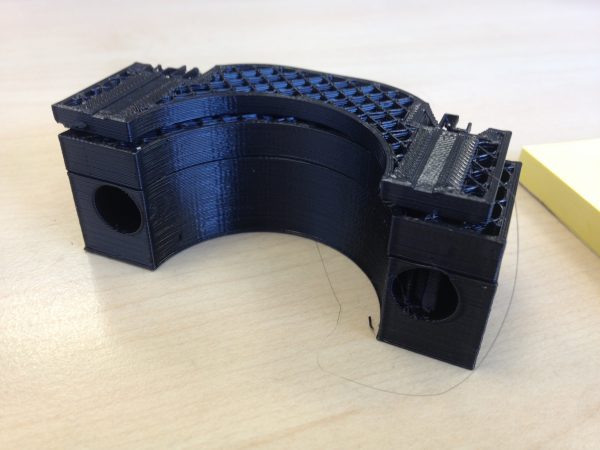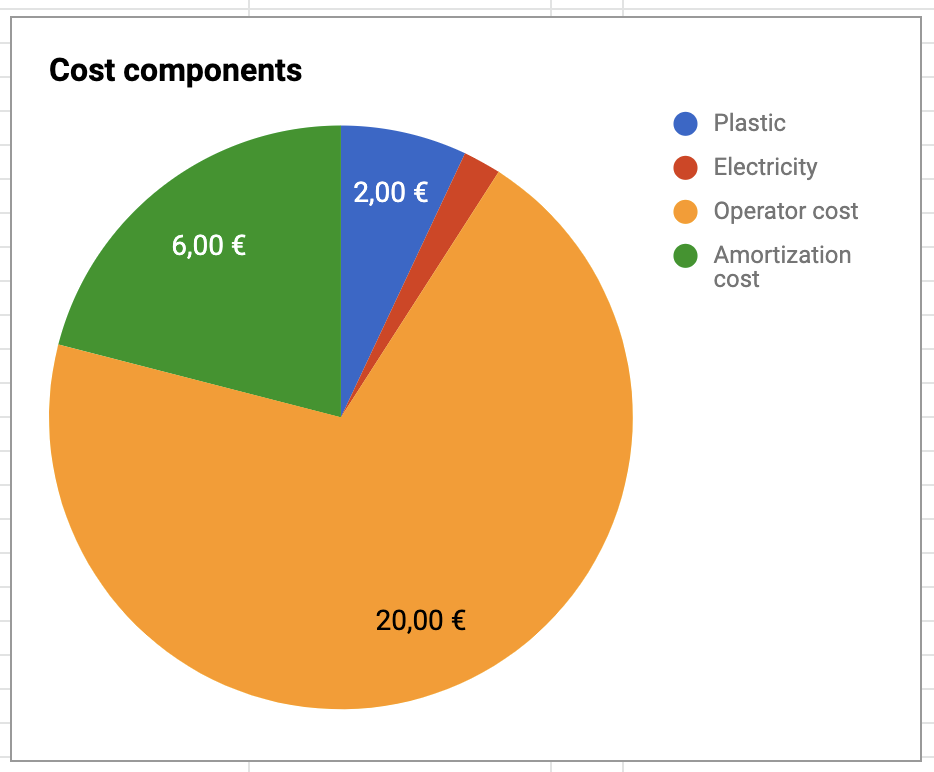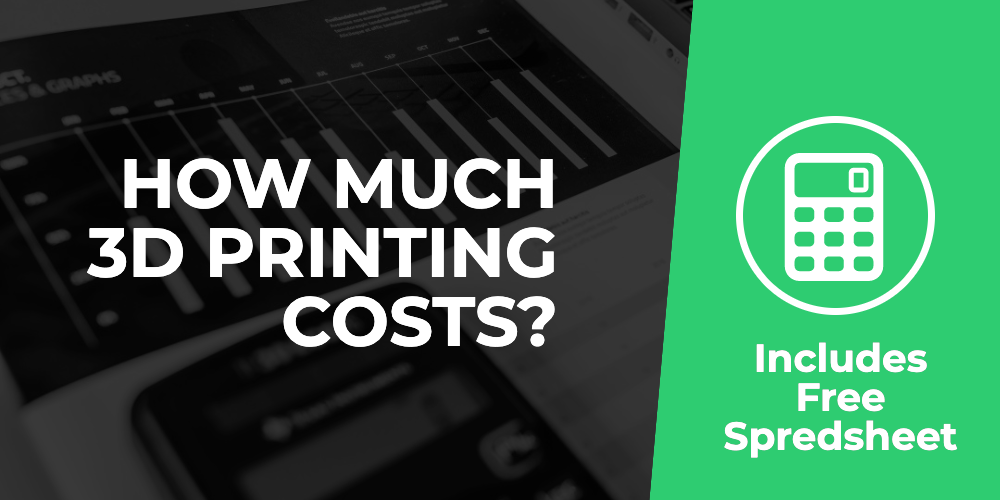Many of our customers wonder how much does 3D printing cost, either because they want to know the price of their parts or because they are interested in buying a 3D printer and need a method to put a cost on their parts.
3D printing is a very new technology and there are still many doubts about it. We have been professionally dedicated to it for 4 years, manufacturing and we have to put a a price on the parts we make. We will share with you everything we have learned about how much 3D printing really costs, the methods to calculate the price of printing parts, hidden costs, etc.
Besides, if you read the full article you will discover that we have shared a downloadable free spreadsheet to calculate yourself the cost of the parts in your company. And if you want, you can also ask us for a quote to find out the cost of your parts.
How much does it cost to print in 3D: the price components of 3D printing
The most important thing to know how much it costs to print in 3D is to determine the components that contribute to the cost of the part. There are many factors that are influencing the cost of the part and we have compiled the most important ones.
Print Preparation Costs
Before you start printing, the person in charge of the machine has to slice the part. Choosing the right slicing parameters, which is done with slicing software such as Cura, Slic3r or Simplify3D, is the basis for the part to be as durable as possible and with the best possible finish.

After laminating, the usual thing is to have to change the filament, put a layer of the fixing product we use (lacquer, 3DLac, adhesive…) and start printing the part, remaining there to monitor the first layers so that everything goes well.
All these previous steps to printing take time from the machine operator and must be taken into account to calculate the cost of the part, as he is not doing other tasks that add value to the company.
Part post-processing costs
Post-processing costs are those that come after the printer has finished the part. Normally you have to let the part cool down and remove it from the printing surface with a spatula. If the part has a support or raft we must remove it carefully and review the areas where markings have been left.
Subsequently it is usually advisable to review the piece with a file, knife or deburrer to remove imperfections and pieces of plastic that have remained to obtain the best possible finish. It is also possible to postprocess the piece with more advanced techniques such as sanding, painting, covering with epoxy, gluing … the possibilities of postprocessing are endless but all of them consume valuable time of the person in charge of it.
Hourly printing costs
The hourly printing costs are one of the most important to consider to know the price of 3D printing. In these costs we include all the costs that are proportional to the hours that the machine is printing our part. They are:
- Amortization cost of the machine. When calculating the cost of using any equipment, the most common practice is to use amortization or depreciation, assuming that when using this equipment we are wearing it down or consuming it. Another way of thinking about amortization is that we divide the total cost of the equipment among all the parts we are going to make with it so that after some time we have “amortized” it. The way to calculate amortization is to divide the price of the printer by the number of hours that we are going to use it until we give it as amortized. You can see the complete calculation and introduce your own data in the spreadsheet included with this article.
- Electricity cost. Although many owners of 3D printers are concerned about the consumption of their printers, the truth is that electricity is one of the cheapest inputs when it comes to calculating how much it costs to print in 3D. With the calculations we have made (the kWh at 0.15€ and a printer that consumes 500W) the price is only 8 euro cents per hour.
- Operator cost. This is the cost of having a person watching the print. For a company that isn’t solely dedicated to 3D printing, it’s not very relevant, since the printers are quite autonomous and can print without the constant supervision of the operator. For us at Bitfab, however, it is the most important cost, as we have to have one person continuously in charge of putting in, taking out, maintaining and monitoring all the printers we produce with.
Cost of printing material

The cost of the 3D printing material is another cost that is always taken into account when printing, but we run the risk of thinking that it is the only one that contributes to the price of the part.
Generally, the cost of filament is going to be small, because the pieces printed in 3D are practically hollow and because the coils are not expensive. There are some cases where the filament can be more expensive: when we use premium or special materials, or when we use large nozzles and a lot of filler (in that case we run out the filament very quickly).
Maintenance cost
Maintenance is a fundamental part of using a 3D printer that is sometimes overlooked. Printers are complex mechanical systems, and just like a car or a CNC machine they have a specific maintenance that must be followed periodically to avoid printing failures.
Most commonly, moving machine parts need to be cleaned and greased, components such as the printing surface or extruder need to be renewed, or damaged components need to be replaced from time to time. Maintenance can be carried out by the person in charge of the printer or by the manufacturer, who offers maintenance and warranty plans for their machines.
Error costs
It happens even with the best machines, all the 3D printer users have had to throw out parts because of a multitude of errors: printing errors, jams, laminating errors, running out of filament…
Although printers have come a long way and are becoming more reliable and easy to use, there will always be a rate of errors when printing, especially when you don’t spend enough time servicing your printers.

Another factor contributing to many errors is lamination. When we see a part we usually decide on the optimal print orientation and we get it printed. When we print the parts we sometimes realize that there is some detail that didn’t turn out well with that orientation, or with the lamination parameters we have chosen, and we have to repeat the printing with a different configuration.
Training cost
The cost of training is another cost that is often overlooked, but it is very important if we are in a company that wants to get the most out of 3D printing.
Ideally, employees should be trained to exploit the technology, from the design phase for 3D printing to machine operation and maintenance. There are many companies and trainers who offer online and in-person courses, and more and more printer manufacturers are offering the possibility of an introductory course when the machine is purchased.
Free 3D Printing Cost Calculator
As you can see, how much it costs to print in 3D depends on many factors, from the electricity consumed by the printer to the operator who handles it. There are different models for calculating the price of a part, but we’ve put all the relevant factors together in a spreadsheet to find out the cost of producing printed parts within your company.
This model is suitable for companies, which are going to have a professional machine in their office or workshop and for which the costs of the person who takes care of the machine are important. The machine operator is always going to stop doing other tasks to prepare the printer, laminate, change the filament, remove the support… and in a company, it is essential to have the employees busy generating value for the customer, not taking care of a machine.
The best of all is that we want to share it for free. You can see it, download it and modify it in this link. It’s just one of the many calculation methods that exist for the cost of 3D printing, but you can take it as a basis to change the input data or to create your own custom model.
Please note that the costs calculated with this model are not Bitfab’s prices. It is a tool to help you calculate 3D printing costs in your company. We generate our rates with a different system, you can ask for a quote in our contact form and we will be happy to give you a figure for your parts:

How much does it cost to print in 3D the example part that we have included? As you can see the price is 31.46€, mainly due to the person who has to keep an eye on the machine and the amortization of the printer. The costs that most often concern us, the filament and electricity, are actually the least important in the price of printing a part.

The conclusion of this model should be that the cost of plastic and electricity consumed by a printed part is derisory, but we have to take into account the hours spent on it to have a complete view of the price of 3D printing in our company.
How much does it cost to print a piece with Bitfab?
We have already talked about how you can calculate the cost of a piece printed in 3D. If you came here looking for the price of 3D printing with a 3D printing service like Bitfab, we’ll help you find it.
We can help you to print prototypes if you do not want to invest in a 3D printer, to make short production series with 3D printing, and to produce parts in FDM, SLA and SLS.
If you want to know how much it costs to print in 3D with Bitfab, just send us a message and we will give you a quotation in less than 24 hours for your parts; you will see that our rates are very competitive!

